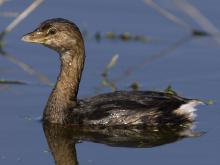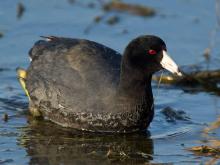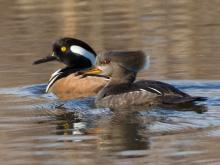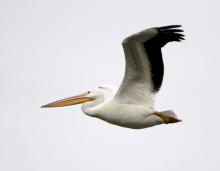Birds
Media

Species Types
Scientific Name
Podilymbus podiceps
Description
Small, brown, ducklike birds, pied-billed grebes have thick gray bills with a dark ring around the middle in summer. They dive underwater to forage.
Media

Species Types
Scientific Name
Fulica americana
Description
Although it floats like a duck, the American coot is actually in the rail family. Note its short tail and wings, pointed white bill, chickenlike walk, and toes with scalloped lobes.
Media

Species Types
Scientific Name
Lophodytes cucullatus
Description
Hooded mergansers have crests that trail behind the head or can be raised to create a circular shape. Their bills are narrow and serrated. Males are black and white with chestnut flanks; females are brown.
Media

Species Types
Scientific Name
Pelecanus erythrorhynchos
Description
Graceful in flight, ungainly on land, and elegant on the water, the American white pelican is one of the largest birds in Missouri.
Media

Species Types
Scientific Name
Oxyura jamaicensis
Description
The ruddy duck is small, compact diving duck with a long, stiff tail that is often cocked up. Breeding males are conspicuous with their dark cinnamon body, bright white cheek patch, black head, and blue bill.
Media

Species Types
Scientific Name
Bucephala albeola
Description
Buffleheads are small, compact ducks with large, rounded heads. They bob lightly in the water, then, in a flash, dive below the surface.
Media

Species Types
Scientific Name
Bucephala clangula
Description
The common goldeneye is a common migrant and winter resident in Missouri. A diving duck, it is usually found on open water of rivers and lakes.
Media

Species Types
Scientific Name
Cygnus buccinator
Description
The trumpeter swan is the largest waterfowl species in North America. It has been absent from the state throughout most of the 20th century, but today occurs as migrants and overwinters in our state.
Media

Species Types
Scientific Name
Anas strepera
Description
The male gadwall is a rather drab-looking duck with a black rear end and a white speculum (wing patch). This dabbling duck is a common migrant in Missouri.
Media

Species Types
Scientific Name
Anas crecca
Description
The green-winged teal is a fast, graceful flyer with an iridescent green wing patch. Teals are relatively small dabbling ducks and have been called the “bantams of the duck tribe.”
See Also







Media

Species Types
Scientific Name
Hemaris diffinis
Description
The snowberry clearwing is a moth that confuses people because it looks like a bumblebee and flies like a hummingbird!
Media

Species Types
Scientific Name
Hyles lineata
Description
The white-lined sphinx moth sometimes confuses people because it flies, hovers, and eats from flowers like a hummingbird. The adults often fly during daylight hours as well as in the night and are often found at lights.
Media

Species Types
Scientific Name
Darapsa myron
Description
The Virginia creeper sphinx moth is common in woods and brushy areas and comes to lights at night. The larvae eat Virginia creeper and grape leaves.
Media

Species Types
Scientific Name
Perimyotis subflavus (formerly Pipistrellus subflavus)
Description
Tri-colored bats, formerly called eastern pipistrelles, are relatively small and look pale yellowish or pale reddish brown. The main hairs are dark gray at the base, broadly banded with yellowish brown, and tipped with dark brown.
Media

Species Types
Scientific Name
Myotis grisescens
Description
Gray myotises are difficult to distinguish from other mouse-eared bats. A key identifying feature of the gray myotis is that its wing is attached to the ankle and not at the base of the toes. It’s an endangered species.
Media

Species Types
Scientific Name
Myotis lucifugus
Description
The little brown myotis (little brown bat) is one of our most common bats, but populations are declining. White-nose syndrome has taken a heavy toll in northeastern states. This species is now listed as vulnerable across its range.
Media

Species Types
Scientific Name
Myotis sodalis
Description
The Indiana myotis, or Indiana bat, summers along streams and rivers in north Missouri, raising its young under the bark of certain trees. It is an endangered species.
About Birds in Missouri
About 350 species of birds are likely to be seen in Missouri, though nearly 400 have been recorded within our borders. Most people know a bird when they see one — it has feathers, wings, and a bill. Birds are warm-blooded, and most species can fly. Many migrate hundreds or thousands of miles. Birds lay hard-shelled eggs (often in a nest), and the parents care for the young. Many communicate with songs and calls.





















